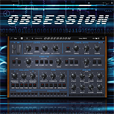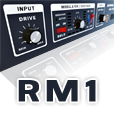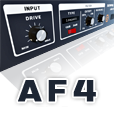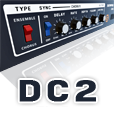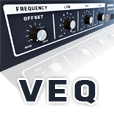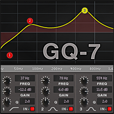The RE-160 is a RMS (= Root Mean Square) compressor, which means that it tracks the average signal energy. Compared to the usual peak compression, this form of compresson is a more relaxed compression that also more closely relates to the perception of loudness. As the tracking signal determines the compressor action, it is most important to shape the sound of a compressor. The RE-160 uses a virtual-analog circuit to calculate the instantaneous RMS signal with zero latency.
Beyond Infinity Compression
A rather unique feature of the RE-160 is the ability to use negative compression ratios. Typical ratios range from 1:1 (no compression) to oo:1 (limiter). The RE-160 allows you to go beyond that by setting a negative compression ratio, which means that signals above the threshold not only get limited to 0 dB, but further attenuated.
Parallel Compression
The RE-160 features parallel compression via a Mix knob on the left side of the rack extension. This control allows to mix the dry and compressed signal for additional flexibility.
Sound Parameters
Input Level
The Input Level knob controls the signal level that is going into the rack extension, with an available range of ±20 dB. Usually the input level should be adjusted such that the signal peaks around 0 dB.
Threshold
The Threshold knob sets the level at which a passage is considered "loud" - that is the point at which the compressor will start working. For example, if you set the threshold to -10 dB, then everything below that level will pass straight through - anything above -10 dB will cause the compressor to start working. As the Threshold parameter is decreased and more compression occurs, the output level is reduced. You may use the Output Level control to raise the level back up to match the input level. Note that the red gain reduction meter on the right always shows you the compressor action- if the LEDs are off then there is no compression going on.
Ratio
Ratio tells the compressor how much to compress those passages that are louder than the threshold. A ratio of 1:1, for example, means that the sound comes out 1 to 1 - as it is - the compressor does not do anything at all. A ratio of 2:1 means that loud passages will be lowered by a factor of 2, that is they will come out only half as loud. A ratio of 4:1, and loud passages will come out 4 times softer, and so on. So the Ratio setting effectively decides how much the passages above the threshold will be compressed.
Output Level
The Output Level knob controls the signal level after compression, with a range of ±20 dB. Usually output gain is adjusted such that the loss of level due to compression is compensated for. For example, if the red gain reduction meter shows a level of 6 dB, then the output gain may be set to +6 dB.
Sidechain Inputs
Using the RE-160s sidechains on the back panel, it is possible to e.g. lower the level of the bass whenever the kick drum comes in. A standard practice in many of today's music genres like EDM etc. The RE-160 features both mono and stereo sidechains.
Back Panel CVs
Like all our rack extensions, the back panel offers CV inputs to modulate the most important sound parameters. A useful extra is the ability to send the current Gain Reduction via CV output. This allows to take advantage of the RE-160s unique RMS tracking and use the gain reduction signal as a modulation source for other devices.




